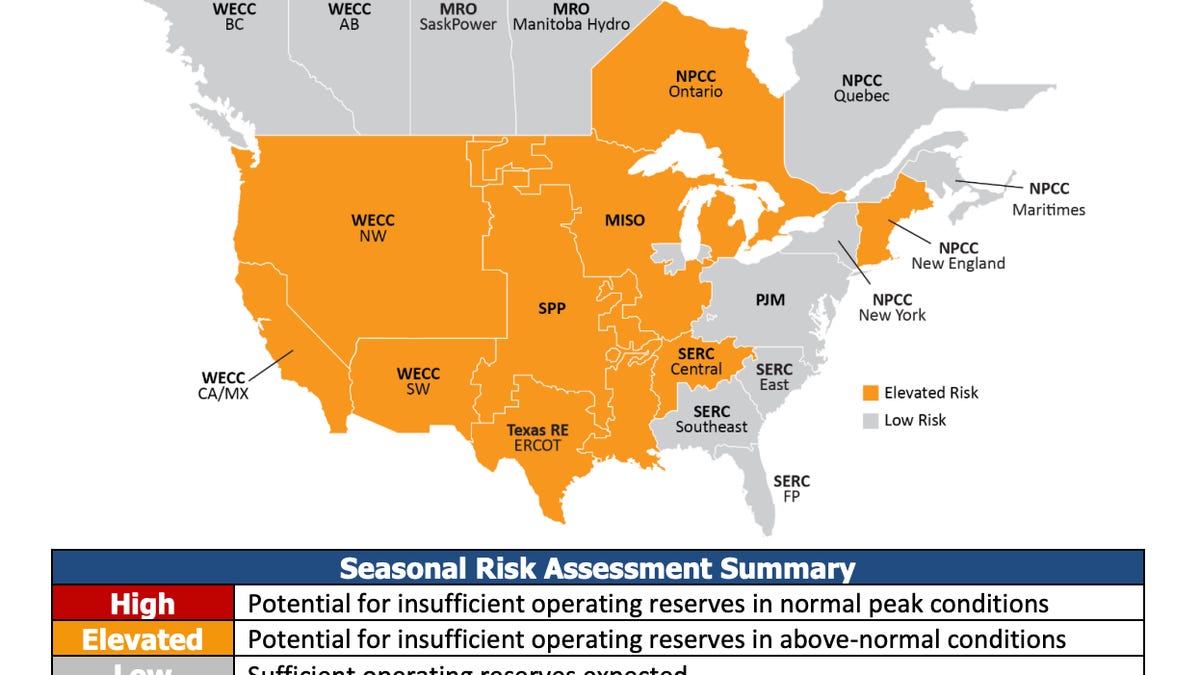Most of the US at 'Elevated Risk' of Energy Shortfalls This Summer, NERC Warns
Here's what could happen in the event of widespread heatwaves this season, and the areas most at risk.

Energy shortfalls could affect two-thirds of North America this summer, the North American Electric Reliability Corporation warns in its latest report.
Periods of "extreme demand" on our energy resources will occur if temperatures spike this season, said NERC, a regulatory authority that oversees the reliability of North America's electrical infrastructure. Areas the NERC said are most risk include the US West, Southwest, Midcontinent, Texas, Southeast Central, New England and Ontario, Canada.
It comes as human-caused climate change makes extreme weather events more frequent and more intense. The US is one of the top three emitters worldwide of human-made greenhouse gas emissions, which largely come from the burning of fossil fuels for energy.
In comparison to last year's report, there are no high-risk areas in the assessment this year, thanks partly to greater use of renewable energy including wind, solar and batteries across the nation. A rainier winter in the west also contributed to a lower overall risk than in 2022.
But while there are no high-risk areas this time, the number of "elevated risk" regions in NERC's annual summer assessment has risen.
"Generator retirements continue to increase the risks associated with extreme summer temperatures, which factors into potential supply shortages in the western two-thirds of North America if summer temperatures spike," Mark Olson, NERC manager of Reliability Assessments, said in a statement.
NERC said elevated risks in each region are due to:
- "Wide-area heat events" that could drive above average demand and strain energy resources in the US West.
- Risk of high temperatures and drought in Texas, which "may result in emergency procedures, including the need for operator-controlled load shedding."
- Lower capacity than last year in New England.
- Reduced capacity in Ontario due to "extended nuclear refurbishment."
- Lack of excess capacity in SPP and MISO areas, leading to greater reliability on wind energy.
- Predicted higher demand and less capacity in SERC Central.
If you live in a region that's at risk of losing power this summer from traditional electrical providers, check out CNET's list of best solar batteries, best portable power stations and best solar generators.
States affected by 'elevated risk' warning
There's some overlap between the energy entities, but here are the states and regions affected by the elevated risk assessment:
- ERCOT (Electric Reliability Council of Texas): Texas.
- WECC (Western Electricity Coordinating Council) - CA/MX: Parts of California, Nevada, and Baja California, Mexico.
- WECC-NW: Colorado, Idaho, Montana, Oregon, Utah, Washington, Wyoming and parts of California, Nebraska, Nevada and South Dakota.
- WECC-SW: Arizona, New Mexico and parts of California and Texas.
- SERC (Southeastern Reliability Council) - Central: Tennessee plus parts of Georgia, Alabama, Mississippi, Missouri and Kentucky.
- SPP (Southwest Power Pool): All or parts of Arkansas, Iowa, Kansas, Louisiana, Minnesota, Missouri, Montana, Nebraska, New Mexico, North Dakota, Oklahoma, South Dakota, Texas and Wyoming.
- MISO (Midcontinent Independent System Operator): All or parts of Arkansas, Illinois, Indiana, Iowa, Kentucky, Louisiana, Manitoba, Michigan, Minnesota, Mississippi, Missouri, Montana, North Dakota, South Dakota, Texas and Wisconsin.
- NPCC (Northeast Power Coordinating Council) ‐ New England: Connecticut, Maine, Massachusetts, New Hampshire, Rhode Island and Vermont.
- NPCC - Ontario: Ontario.

